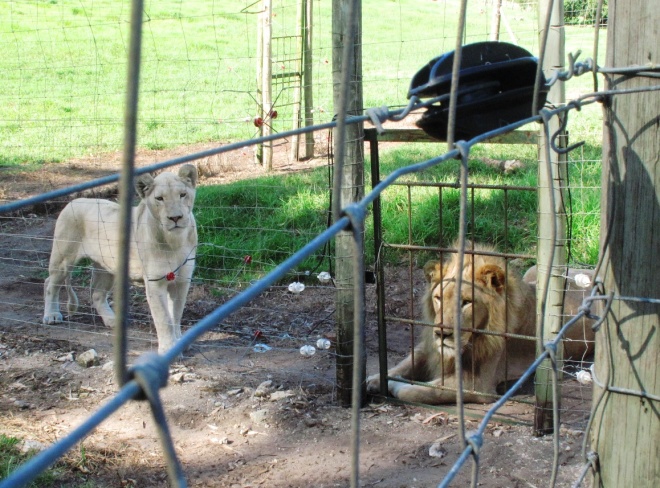After last year’s High-Level Panel (HLP) submission process in South Africa, the Department of Forestry, Fisheries and the Environment (DFFE) released its HLP Report in May 2021. Among many proposals, the DFFE proposes to enhance the conservation of lion and rhino species in the wild by halting their commercially driven domestication/exploitation. This is warmly welcomed by all those seeking an enduring and irreversible track to the fair, ethical and moral treatment of South Africa’s wildlife/animals. The swift implementation of this halting of domestication of all exploited captive bred species is key, with many potential pitfalls and loop-holes that could be exploited by the captive breeding industry in the interim.
On 28 June 2021, the DFFE requested comment on the DFFE’s proposed way forward – Government Notice 566 of 2021 “Comments invited on the draft policy position on the conservation and ecologically Sustainable Use of elephant, lion, leopard and rhinoceros” as notified in Government Gazette, Vol. 672, No. 44776, Department of Forestry, Fisheries and the Environment (DFFE).
IWB’s Submission to this Government Notice is given here – “Draft Policy Position on The Conservation and Ecologically Sustainable Use of Elephant, Lion, Leopard and Rhinoceros,” dated 26 July 2021 – The submission highlights the many factors that need to be considered if the “draft policy’s” intended conservation and welfare outcomes are to be realised in reality and South Africa’s reputation is to be enhanced.
The draft policy suggests that “Communities have identified the positive impact of sales of stockpiles, and there is global interest from NGOs’ and philanthropists willing to buy stockpiles horn and ivory in order to then have these destroyed.” However, the conclusion is drawn in IWB’s submission that the proposed “NGOs and philanthropists willing to buy stockpiled horn and ivory” could potentially perpetuate the commodification and speculative exploitation of rhino horn and ivory. The draft policy also maintains the ‘hope’ that one day international trade in rhino horn may emerge thanks to gathering “the long term, global consensus to allow international trade in rhino horn” or “the long term, global consensus to allow international trade in ivory” – this is unlikely to deter continued speculative stockpiling. The prospect given in the draft policy that captive rhino could be returned to wild populations within South Africa and the region is welcomed.
IWB’s submission highlights the disappointment that leopards continue to be promoted within the draft policy as hunting trophies because leopards “are an important component of international hunting packages, making such packages internationally competitive” – these are commercial arguments, not ones based on a recognisable conservation imperative. Elephant trophy hunting is not explicitly covered in the draft policy, so its continuation is seemingly given tacit support by the DFFE.
Furthermore, the DFFE envisages South Africa’s conservation reputation being restored upon implementation of the draft policy’s proposals, promoting “best practice” and “responsible hunting” – neither of these terms are specifically defined in the draft policy and in that absence, remain open to subjective interpretation and on-going abuses.
The One Welfare and redefined Sustainable Utilisation definitions given with the draft policy are welcomed, both enshrine the humane treatment of animals/wildlife and the prevention of suffering etc. with a recognition of the “intrinsic value on animals as individuals” (Judge Kallopen, Pretoria High Court, 6 August 2019, Judgement, Case No. 86515/2017). The regulation and enforcement of policy is key to ensure compliance, which the draft policy recognises – the required implementation and funding of such remains to be seen.
However, there is clearly a dichotomy between the draft policy’s stated recognition of an individual animal’s continued well-being/intrinsic value and the draft policy simultaneously promoting the targeting of an individual animal as a hunting trophy and the suffering that inevitably inflicts on an individual animal. The draft policy hopes trophy hunting will “re-position South Africa as a destination of choice for legal, humane, regulated and responsible hunting of the 5 iconic species” and somehow also appeal to general, non-consumptive wildlife tourism. There is a clear incompatibility, which can only be overcome if one accepts any justifications given to excuse trophy hunting as a necessary evil where the suffering inflicted on an individual animal is a necessity – many will not accept on purely ethical/moral grounds.
The draft policy rightly points out that “Trophy hunting is under increasing international scrutiny and all activities related to this must be done using best practice [which lacks definition] and full transparency to prevent irresponsible hunting practices creating reputational damage and international outcry.” I would suggest that it is inevitable that trophy hunting will continue to negatively impact South Africa’s reputation, as its proponents seem unable to stop themselves from revelling in their grotesque exploits.
Finally, the Transformative vision within the draft policy, giving fair, equitable access to wildlife/animal derived resources and income is understood, but caution must be given to this not being interpreted as a means to exploit animals/wildlife in unbounded market expansion – which is likely to make the problems inherent in such practices far worse – potentially taking the intended equality and dignity clearly in the wrong direction.
Further Reading
“I SUPPORT THE END OF THE CAPTIVE BIG CAT INDUSTRY,” Four Paws
“Rhino ‘kingpin’ arrested again for dealing in horn,” Don Pinnock, Daily Maverick, 22 July 2021
“Progress in ending captive lion breeding as government passed draft policy,” Blood Lions, 30 June 2021
“NGO Appeal for Closure of Captive Lion Breeding Industry and Associated Activities,” IWB, 9 December 2020
